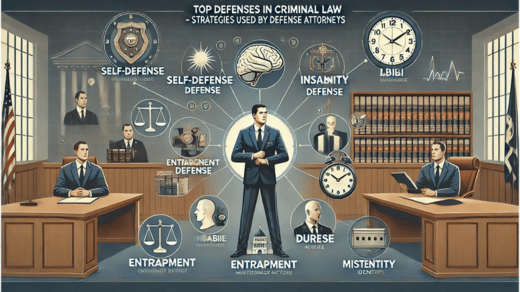Criminal defense attorneys play a critical role in ensuring justice by defending individuals accused of crimes. Their job involves building a defense strategy that challenges the prosecution’s case and protects the rights of the accused. Various defense strategies are utilized based on the circumstances, type of crime, and evidence involved. Here are the top defenses in criminal law commonly used by defense attorneys.
1. Innocence
One of the most straightforward defenses in criminal law is proving innocence. The defense attorney focuses on demonstrating that the accused did not commit the crime. This strategy involves providing an alibi, presenting evidence that someone else committed the crime, or showing that the prosecution lacks enough proof. The burden is on the prosecution to prove guilt beyond a reasonable doubt, and when an attorney can effectively argue innocence, the case may be dismissed.
Key Tactics:
- Presenting an alibi that proves the defendant was elsewhere during the crime.
- Questioning the validity of the prosecution’s evidence.
- Introducing new evidence that points to another suspect.
2. Self-Defense
In cases involving violent crimes, such as assault or homicide, self-defense is a common defense strategy. A defense attorney will argue that the defendant’s actions were justified because they were protecting themselves or others from harm. For this defense to be valid, it must be proven that the defendant believed they were in imminent danger, and the force used was proportionate to the threat faced.
Key Tactics:
- Establishing that the defendant faced an immediate threat of harm.
- Proving the defendant’s actions were necessary to prevent injury.
- Showing that the level of force used was reasonable and not excessive.
3. Insanity Defense
The insanity defense is a less frequently used but powerful strategy. In this defense, the attorney argues that the defendant was not of sound mind at the time of the crime and therefore could not understand the wrongfulness of their actions. If successful, this defense can result in a not-guilty verdict due to insanity, leading to mental health treatment rather than prison time. However, it is difficult to prove and requires extensive psychiatric evaluation.
Key Tactics:
- Providing medical or psychiatric testimony to demonstrate mental illness.
- Showing that the defendant could not distinguish between right and wrong.
- Arguing that the mental disorder directly contributed to the criminal behavior.
4. Mistaken Identity
Mistaken identity is another defense tactic used when a defendant is wrongfully accused due to being mistaken for someone else. This is common in cases where eyewitness testimony plays a major role. Defense attorneys work to create doubt about the reliability of the prosecution’s witnesses, showing that the defendant is not the person who committed the crime.
Key Tactics:
- Challenging eyewitness testimonies as unreliable or inaccurate.
- Presenting alternative evidence that casts doubt on identification.
- Using forensic evidence, such as DNA or fingerprints, to exonerate the defendant.
5. Entrapment
Entrapment occurs when law enforcement induces someone to commit a crime they otherwise would not have committed. This defense argues that the defendant was persuaded or coerced into criminal behavior by authorities. Defense attorneys must prove that without the government’s encouragement, the crime would not have been committed.
Key Tactics:
- Demonstrating that law enforcement used undue pressure or deceit.
- Proving that the defendant was not predisposed to committing the crime.
- Presenting evidence of government misconduct or overreach.
6. Duress
The duress defense is used when a defendant commits a crime because they were forced to do so under the threat of violence or harm. This defense argues that the defendant had no free will and acted out of fear for their life or safety. It is a valid defense in many criminal cases, except for serious crimes like murder.
Key Tactics:
- Proving the defendant faced immediate and serious threats.
- Showing that the defendant had no reasonable way to escape the threat.
- Arguing that the crime was committed under coercion or threat of harm.
7. Lack of Evidence
A strong defense in criminal cases is highlighting the lack of sufficient evidence against the defendant. Defense attorneys emphasize the gaps in the prosecution’s case, pointing out where the evidence is circumstantial or flawed. This strategy seeks to create reasonable doubt in the minds of the jury, leading to acquittal.
Key Tactics:
- Challenging the credibility of the prosecution’s witnesses and evidence.
- Exposing inconsistencies in the evidence presented.
- Arguing that the prosecution has not met the burden of proof.
Conclusion
Defense attorneys use a wide range of strategies to protect their clients in criminal cases. From proving innocence to claiming self-defense, each approach is tailored to the specific circumstances of the case. Whether through challenging the evidence, providing alternative explanations, or highlighting procedural errors, criminal defense lawyers play a pivotal role in ensuring that justice is served fairly. The outcome of a case often hinges on the attorney’s ability to implement these defense strategies effectively, making their work critical in the criminal justice system.


